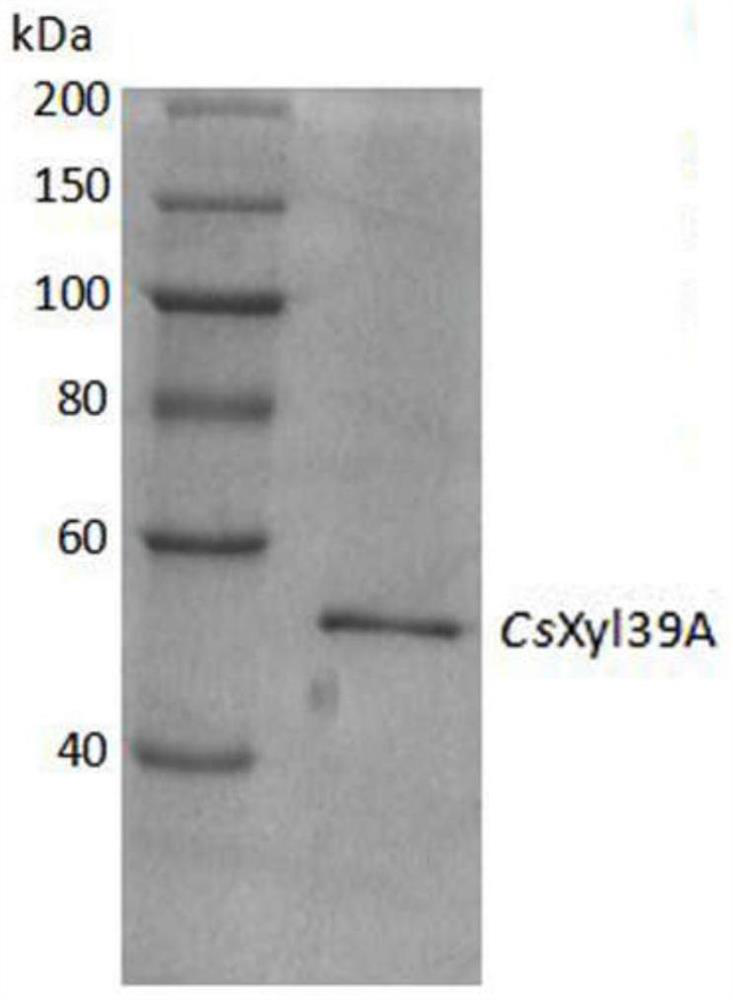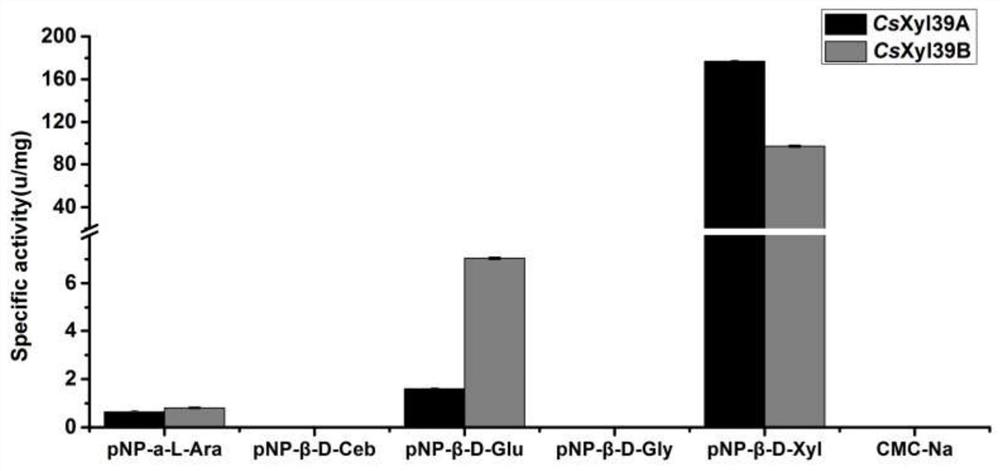β-Xylosidase and its application
A technology of xylosidase and xylosyl, which is applied in the application field of biotransformation and can solve the problems of large effect and poor tolerance.
- Summary
- Abstract
- Description
- Claims
- Application Information
AI Technical Summary
Problems solved by technology
Method used
Image
Examples
Embodiment 1
[0060] Example 1, Obtaining of β-xylosidases CsXyl39A and CsXyl39B and their amino acid sequences
[0061] Genomic DNA of Caldicellulosiruptor saccharolyticus (ATCC 43494 / DSM8903) was extracted and used as a template for PCR amplification with forward primer 1 and reverse primer 1 (see Table 1) to obtain β-wood The gene sequence of glycosidase CsXyl39A is shown in sequence 3. Perform PCR amplification with forward primer 2 and reverse primer 2 (see Table 1) to obtain the gene sequence of β-xylosidase CsXyl39B, as shown in sequence 4.
[0062] The PCR amplification system and conditions of the two are the same, specifically: 50 microliters of PCR amplification system includes 1 microliter of genomic DNA (15 ng / microliter), 25 microliters of 2×EASYPfu SuperMix, 1 microliter of Primers (10 micromolar) and 22 microliters of sterile ultrapure water. The PCR reaction conditions were: pre-denaturation at 95°C for 5 minutes; denaturation at 94°C for 30 seconds, annealing at 55°C for...
Embodiment 2
[0067] Embodiment 2, the mensuration of β-xylosidase hydrolysis activity:
[0068] The enzyme activity was determined with p-Nitrophenyl-β-D-xylopyranoside (pNP-X) as the substrate. In 100 microliters of sodium citrate buffer solution (pH 5.0), 80 microliters of pNP-X (10 mmol / liter) and 20 microliters of different concentrations of the β-xylosidase CsXyl39A obtained in the above-mentioned Example 1 were sequentially added Or CsXyl39B, incubate in a water bath (75° C.) for 5 minutes, then add 100 microliters of 2 mol / liter sodium carbonate solution to terminate the reaction. The reaction solution was then placed in a spectrophotometer, and the absorbance was measured at 405 nm (see image 3 ). 1 millimole of p-nitrophenol is released in hydrolyzing the substrate per minute, which is defined as 1 enzyme activity unit.
[0069] Determination results: the results of the hydrolysis activity of the enzyme are as follows: image 3 It was shown that the specific enzyme activities...
Embodiment 3
[0070] Embodiment 3, the influence of organic solvent on the hydrolysis activity of β-xylosidase CsXyl39A:
[0071] The hydrolysis activity of β-xylosidase was determined with p-nitrophenol xyloside pNP-X as substrate. Add respectively the organic solvent (machine solvent is methyl alcohol, ethanol, Virahol, n-butanol, acetone or acetonitrile) that makes final concentration in the system be different content in the hydrolysis reaction system, and reaction system is in 100 microliters sodium citrate buffer solution (pH 5.0), add 80 μl of 10 mmol / L pNP-X, and then add 20 μl of CsXyl39A enzyme mixed with the above organic solvent, incubate in a water bath (75°C) for 5 minutes, and then The reaction was terminated by adding 100 microliters of sodium carbonate solution (2 mol / liter). The reaction solution was then placed in a spectrophotometer, and the absorbance was measured at 405 nm (see Figure 4 ). 1 millimole of p-nitrophenol was hydrolyzed from the substrate per minute, w...
PUM
 Login to View More
Login to View More Abstract
Description
Claims
Application Information
 Login to View More
Login to View More - R&D Engineer
- R&D Manager
- IP Professional
- Industry Leading Data Capabilities
- Powerful AI technology
- Patent DNA Extraction
Browse by: Latest US Patents, China's latest patents, Technical Efficacy Thesaurus, Application Domain, Technology Topic, Popular Technical Reports.
© 2024 PatSnap. All rights reserved.Legal|Privacy policy|Modern Slavery Act Transparency Statement|Sitemap|About US| Contact US: help@patsnap.com










